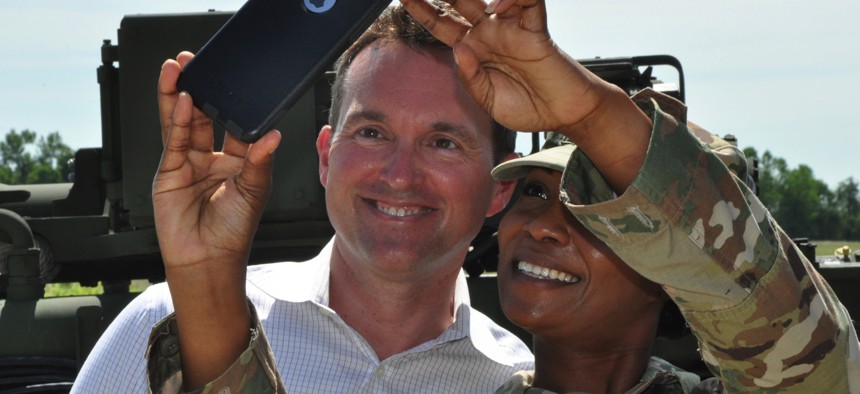
A National Guardsman takes a selfie with then-Army Secretary Eric Fanning in 2016. U.S. Army
Train Troops to Use Social Media More Effectively
It’s a tool, like any other. We may as well know how to use it.
No less for the military than for the rest of American society, social media has proven a double-edged sword. It creates operational security risks and gives a bullhorn to the boneheaded. But to argue, as Task & Purpose’s Jeff Schogol did recently, that social media is too dangerous to allow troops to use it, is to miss the ways the military could make better use of these new tools. In particular, the military should think harder about, and better train its members in, using social media to better connect the military to the larger society it serves.
There is no question that some service members’ social media escapades have resulted in disciplinary action, headaches for PAOs, and hiccups in the dialogue surrounding the professionalism of the military. These instances can be looked at narrowly as embarrassments that justify a social media ban — or as opportunities to address longstanding problems.
As the military works to crack down on racism and sexism within its ranks, social media posts can help identify troops whose behavior does not meet the expected standard. (E.g., the viral TikTok video in which Pfc. Jarrett Morford uttered racial slurs and threatened to shoot Chinese people.) As Nolan Hedglin has written, social media opens up the military to more scrutiny over the behavior of individuals, but that is not a bad thing. Those who believe in a military accountable to the American public, that takes threats to combat readiness such as racism, sexual assault, and other issues in the military social media has helped shed light on, should welcome this development.
Moreover, social media allows the military and civilian worlds to connect on a wider and deeper level than ever before. Twitter in particular has revealed its promise in this regard. The #MilTwitter community has developed into a place for military members of all ranks, national security professionals, and civilians interested in the military to come together and learn from and about one another. Certain users, such as @LadyLovesTaft and @LethalityJane have garnered tens of thousands of followers who are curious about these service members’ lives. Other military members choose to operate on Twitter anonymously, which allows them to protect their identity and unit affiliations while still contributing to important conversations on topics like sexual assault and discrimination in the military.
Service members’ ability to use social media also allows higher-ups, such as Maj. Gen. Tammy Smith and Maj. Gen. Patrick Donahoe, to listen to and respond to the concerns of their subordinates and the civilian population. Service members, interested civilians, national security academics and professionals, politicians, and journalists are now regularly interacting with one another on social media. This helps the greater population view service members as people beyond their military affiliation, which is key to healthy civilian-military relations. Especially in politically turbulent times, it is important to remember that, by and large, we’re in this together, and social media provides that link.
Social media further provides a place for service members stationed across the world to come together seeking friendship, mentorship, and general support. As an NROTC midshipman, I signed up for Twitter this past summer to interact with other midshipmen and cadets, as well as junior officers to ensure I can be the best naval officer and best leader to my future sailors. I have been connected to officers in every branch of the military, with a wide range of service years under their belts. Beyond my own unit, I now have an enlarged community of service members and fellow midshipmen and cadets that are looking out for one another and helping each other succeed. This community is priceless.
Many service members have already picked up on the many benefits social media has to offer their personal careers and the services at large. A uniform education in using social media effectively and positively, beyond refraining from posting about sensitive or inflammatory subjects, can help. While it is hard to methodize the often organic relationships that spring up from social media interactions, emphasizing social media as a way to expand one’s professional network, have a voice on issues (within the parameters of the UCMJ), and to brand yourself is a great first step. Such a push for positive engagement would also reduce the responsibility on PAOs and higher military leadership, which largely bears the burden of public relations for the services.
As Angry Staff Officer — Army officer, writer, and avid Twitter user — puts it, social media is a place for discourse and to break down stereotypes. Ultimately, the services and civilian-military relations are better because of it.



